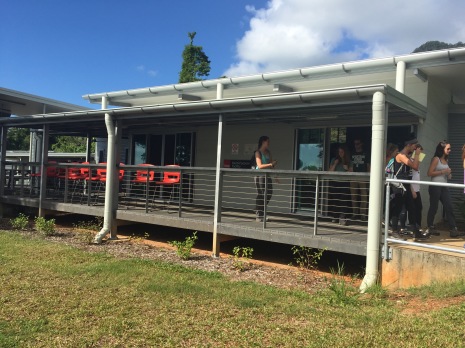Hello! Thank you for following our blog and keeping up with our trip! My name is Courtney Susterich and I was day leader today with Chrissy. We started our morning with breakfast at 7:45. For breakfast today we had toast, cereal, muffins, granola bars, and our choice of fruit between mandarin oranges, bananas, pears, and apples. We then piled into our two busses and headed to the Daintree Rainforest, which is part of the Wet Tropics Heritage Area and has the largest biodiversity out of anywhere in Australia! On the bus we listened to our morning song, “Go” by The Chemical Brothers (now everyones favorite song) to get us excited for the day.
Our first stop of the day was with Raymond at the multi purpose room to talk about the Canopy Crane on their plot of land in the Daintree Rainforest. The crane was constructed in November of 1998 and is 48 meters high, which is 8 meters over the tallest tree in the area and covers about one hectare of land. To build the crane took 2 days, but 42 different loads. It was built using a helicopter that picked up the steel and concrete pieces from neighboring land and then placed them in the structure of the crane and bolted them in. Using the helicopter caused all the leaves on the trees in helipad area to fall off, but they soon grew back and the damage can not be seen anymore. The funding of the crane comes from James Cook University and the Australian Research Councils Competitive Infrastructure Scheme. Funding also comes from the researchers who conduct studies and collect data on the site and student groups, like us, who come and tour the crane and forest. There was one major research project going on today and it was the drought infrastructure experiment. This experiment covers part of the forest floor to exclude rainfall from the area during the dry seasons to mimic an extreme drought. They are conducting this experiment to see the effects an extreme drought would have on the ecosystem because models are predicting that dry seasons are just going to get drier. The goal of the Daintree Rainforest Observatory is to advance lowland rainforest research in Australia while working to benefit the tropics worldwide.
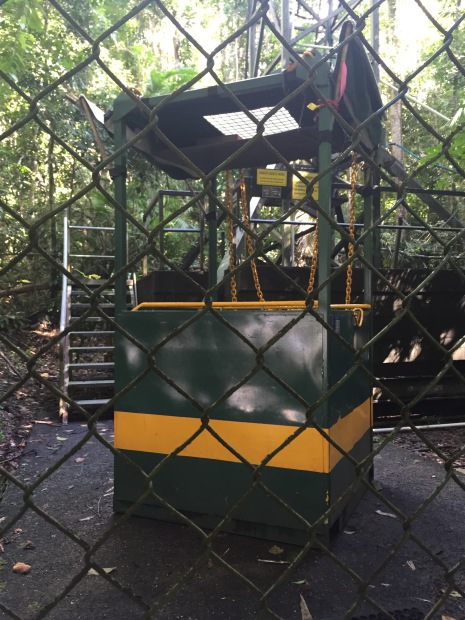
The gondola that the researchers ride in to assess the rainforest.
The purpose of the crane is to monitor how plants and invertebrates respond to climate change. They are looking at the influences on variability of carbon and water fluxes in lowland rain forests, the effect climate change has on rainforest productivity, the decrease in ground fluxes of carbon water in response to climate, the variation in insect population in relation to ecosystem and productivity and climate, and finally, the annual variations in flowering and fruiting phenology in lowland rainforest in relation to climate.
Before we could visit the canopy tree, we had to go through a hazard induction to be aware of the potential dangers in the rainforest. We learned about various hazardous plants such as the stinging tree where a sting can cause pain that lasts for months. To prevent the risks of touching the plant we were required to wear long pants and closed toed shoes. Some of the animals that we talked about were ponerine ants that will sting you and cause pain and swelling. We also talked about various venomous snakes such as the Red-bellied Snake, coastal taipan and the small eyed snake. We, luckily, did not come in contact with any venomous snakes on our trip through the forest. We then walked down the path to see the canopy crane up close, but unfortunately the crane was not on today so we could not see it in action.
Besides the canopy crane, the forest also had a re-vegetation spot in the rainforest to produce more native trees in an area where there were only grass and rocks before. The vegetation was planted 6 years ago, but it wasn’t monitored at first and the plot decreased in half. This showed that the vegetation needs to be monitored to grow correctly. The reason for planting these trees is to increase the biodiversity of the area, help offset carbon, carbon sequestration, create wildlife corridors, help manage salinity, and act as a climate buffering system. In this specific plot, there was 1,250 trees planted, with 68 species and 25 different families. The trees are tagged so the researchers can assess mortality rate of the trees, tree health, herbivory (insect attack on the trees), and flowering/fruiting of the trees.
On our way to the next location we noticed that the road was unusually bumpy and there were more speed bumps than usual. Our tour guide, Paul, explained to us that the road was bumpy to protect the cassowary population. The noise of the cars rattling over the bumpy road and going over the speed bumps mimics the sound a large cassowary would make, causing the other cassowaries to stay away. This helps protect their population size because they are not getting hit by cars as often as they would if the cars did not make so much noise. I found this very interesting because I haven’t heard of a tactic like that used in the United States and wonder if something like that would work to keep deer off the roads, especially in Michigan.
Next, we took a walk through the Noah Valley. This valley is very special in the fact that it is the only pure forest left in the world. This forest is also known as an ecological refuge valley. This site is also a world heritage site and was first recognized as valuable in the 70’s. The sad part about the park is that it is protected for the sole economic reason of tourism. The benefit of it remaining natural and building pathways is it is allowing tourists to come and visit the valley and make a connection with it that they might fall in love with and want to conserve. Some may think that building the boardwalk was very unsustainable and harmed the ecosystem, but the reality of it is that it is benefiting the valley. Paul O’Dowd explained that if the board walks were not present, disabled or people with fear of spiders and snakes would not be able to walk through the valley due to the uneven terrain and fear of what is in the forest. By having the boardwalk, people can come and see the valley and want to sustain the way it was when they first saw it, and that will make the valley still available for future generations to have. There is over 800 species of trees in the Noah Valley. 37 of these species are mangrove trees.
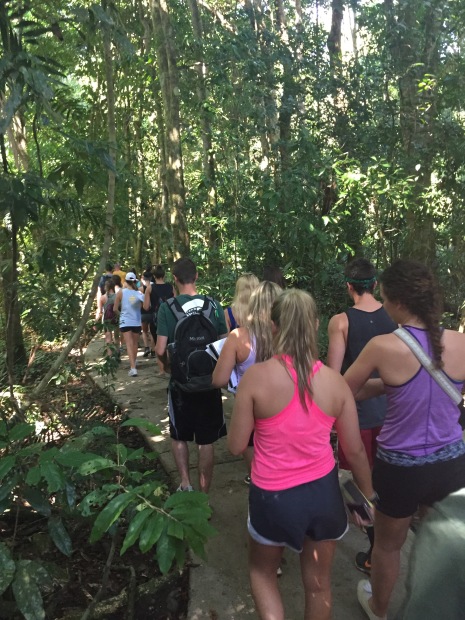
The group walking through the Noah Valley.

This is a strangler fig tree. It is a unique species of tree that wraps itself around another tree, eventually taking over multiple trees.
Lunch was after the nature walk. We went to Cow Bay where we had the option of getting a veggie burger, beef burger or chicken burger. The burgers also came with chips (French Fries as we know it). They are known for having the best burgers in town. The food was devoured by all of us and it was nice to relax and talk.
The Discovery Centre was next and we met back up with Paul O’Dowd and we walked another boardwalk to the canopy tower. Before we climbed the tower, Paul talked about how this specific rainforest is classified as a “Class 1A Complex Mesophyll Vine Forest”. The Class 1A represents how diverse the plant and wildlife is in the forest and a 1A rating is the best rating it can get. Complex stands for the architecture not being a simple structure. Mesophyll represents the average leaf size and the leaf size in this rainforest is medium, thus the Mesophyll title. The canopy is held together by tree like vines and this is where the vine comes from. We learned that there is a seed in the rainforest that helps prevent the replication of the HIV/AIDS strain and that is why AIDS is not as commonly talked about in today’s world.
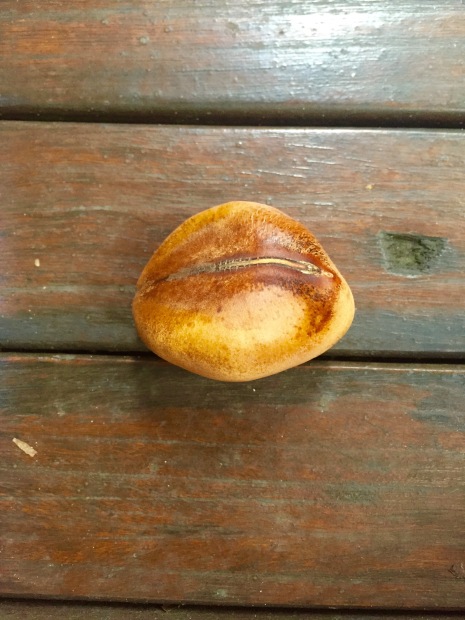
The black bean seed that is used to help control AIDS.
Once on the canopy tower, which is 23 meters high, we talked about how the mangroves, the Great Barrier Reef, and the rainforest are all interconnected. The rainforest provides nutrients that the reef needs to survive from its leafs and sticks. This water is filtered by the roots of the mangroves so only the nutrients that the reef wants gets through. The mangroves also provides a habitat for the animals of the reef to plant their eggs. The fish can then hatch and use the nutrients in the mangroves to grow and then go out to the reef. The reef protects the mangroves by stopping the surf because mangroves would not survive if the waves were large. The lagoon that is in between the reef and the forest provides an area for hot, wet air to rise and the air will go towards the rainforest. Once the trees come in contact with this warm air, they release chemicals that will strip the water from the air, forming water droplets. It was interesting to find out how three seemingly different ecosystems all rely on each other for survival.
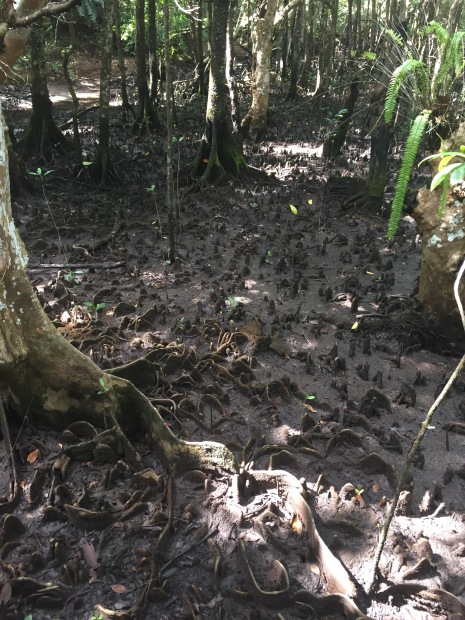
Above is a picture of the mangroves. Their roots grow above ground to help absorb oxygen since the soil is not oxygen dense.
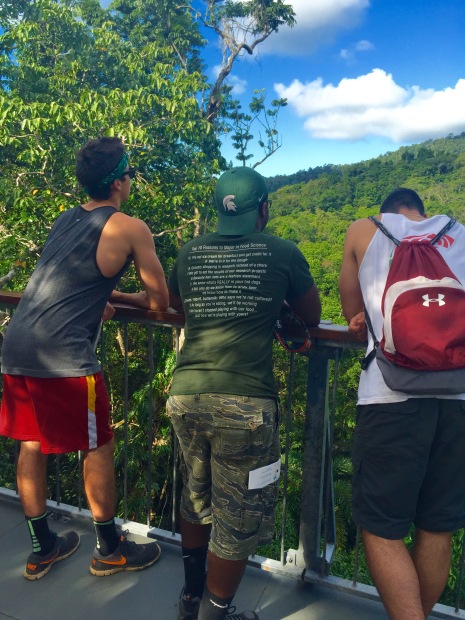
Joey, Quan, and Alex taking in the scenery on top of the tower.
After the Discovery Centre we travelled back to our hotel at Cape Tribulation Beach House where we had a reflection of the past couple of days around the pool. Once reflection was over, it was time for dinner which was either chicken Parmigiano, steak, fish, or a stuffed pepper salad. The rest of the night was spent hanging out and writing our papers that are due in a few days. Overall, we had a great day learning all about the rainforest and all the ways Australia is conserving its natural beauty!
The things we learned today that relate to sustainability are that at the Daintree Forest Observatory they planted new trees in their re-vegetation area that are native to the land and would help offset carbon and increase the diversity of the area. Increasing the diversity of the area allows for different species to inhabit the area. Also, when performing research at the site, they check to see if their experiment will disrupt the sustainability of the system or not and if it does, they will not allow the research to take place. Everywhere we went today was very conscious about the harm humans have on the environment. To eliminate soil and root erosion, the Noah Valley and the Discovery Centre created board walks that went through their sections of the rainforest. By having the soil not erode, the wildlife has the ability to grow and mature in a more natural way and will be able to continue to do so for years to come.
Thanks for checking in and keep checking back to see what we are doing our last few days down under!
Daintree Rainforest Page: http://www.daintreerainforest.net.au
Daintree Rainforest Observatory: http://www.jcu.edu.au/canopycrane/
Additional information about the Noah Valley: http://www.tropicaltours.com.au/blog/183/
The Discovery Centre: http://www.daintree-rec.com.au
Mangroves information: http://www.mangrovewatch.org.au/index.php?option=com_content&view=category&layout=blog&id=81&Itemid=300198
Black Bean Seed: https://www.anbg.gov.au/gnp/interns-2002/castanospermum-australe.html
Live view of the rainforest and recent images: https://www.facebook.com/daintreediscovery/app_838287612849855

